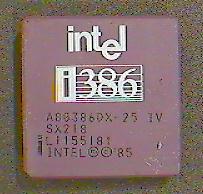 |
|
|
|
In the Forums... |
Posted: February 26, 2001 Written by: Dustin "TimmyC" Jones Intel's 286 The Intel 80286 was released in 1982 and is commonly referred to as simply the 286. The 286 came in 8, 10, and 12 MHz flavors, sported a full 16-bit architecture. It also had a new feature: protected mode, which allowed multiple programs to run using the same memory without fear of crashes. Unfortunately, once in Protected Mode, you were stuck there, earning the 286 the name 'brain dead'. The 386 1985: Now, here's where the good stuff comes about. Intel's 80386, or 386, featured powerful 32-bit architecture and built-in multitasking and memory management units. The 386 came in whopping 16, 20, 25 and 33 MHz speeds. The 386's Virtual Mode allowed it to create Virtual x86 machines which each program had, and share processor cycles between them. Of course, this required more advanced operating systems like OS/2 and Windows 95 to take full advantage of it. It's too bad that running Windows 95 on a 386 would be a more painful process than getting your teeth yanked by a 400 pound gorilla wielding an ice pick. Windows 3.1 really didn't care for all that fancy multitasking hoopla.  DX-25: Now THAT is power! The 486! Released just before 1990, the 80486, or 486 came in two flavors: a DX and an SX model. The DX model featured for the first time, an on-board FPU (Floating Point Unit) that eliminated the need for the purchase of a separate math co-processor. The 486 featured another first in x86 history: Onboard cache! The original 486DX came in speeds of 25, 33 (I had one of these!) and 50MHz. The 486 was a huge hit with consumers and can almost be credited with a boom in PC sales. |
||
|
| |||
|---|---|---|---|